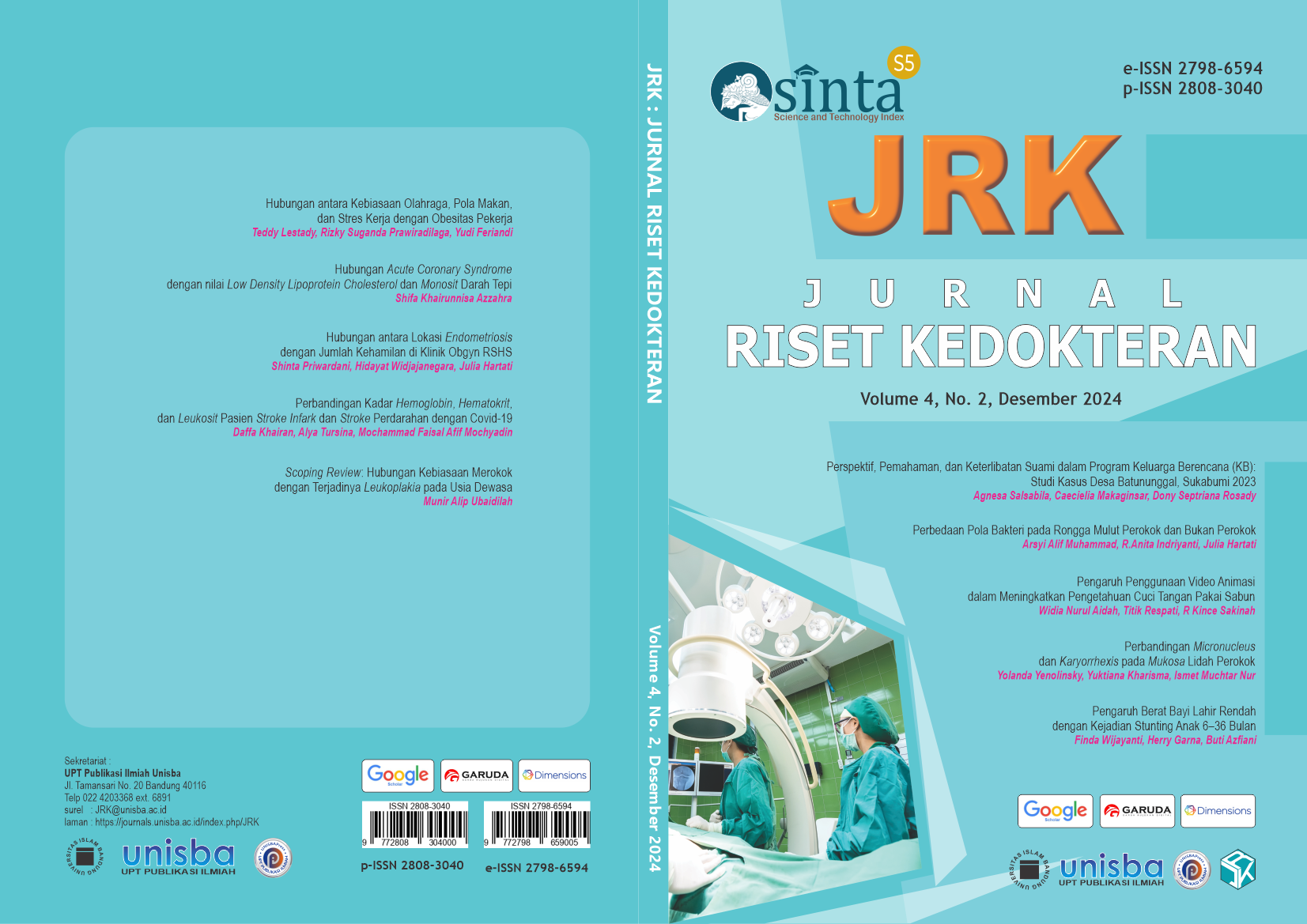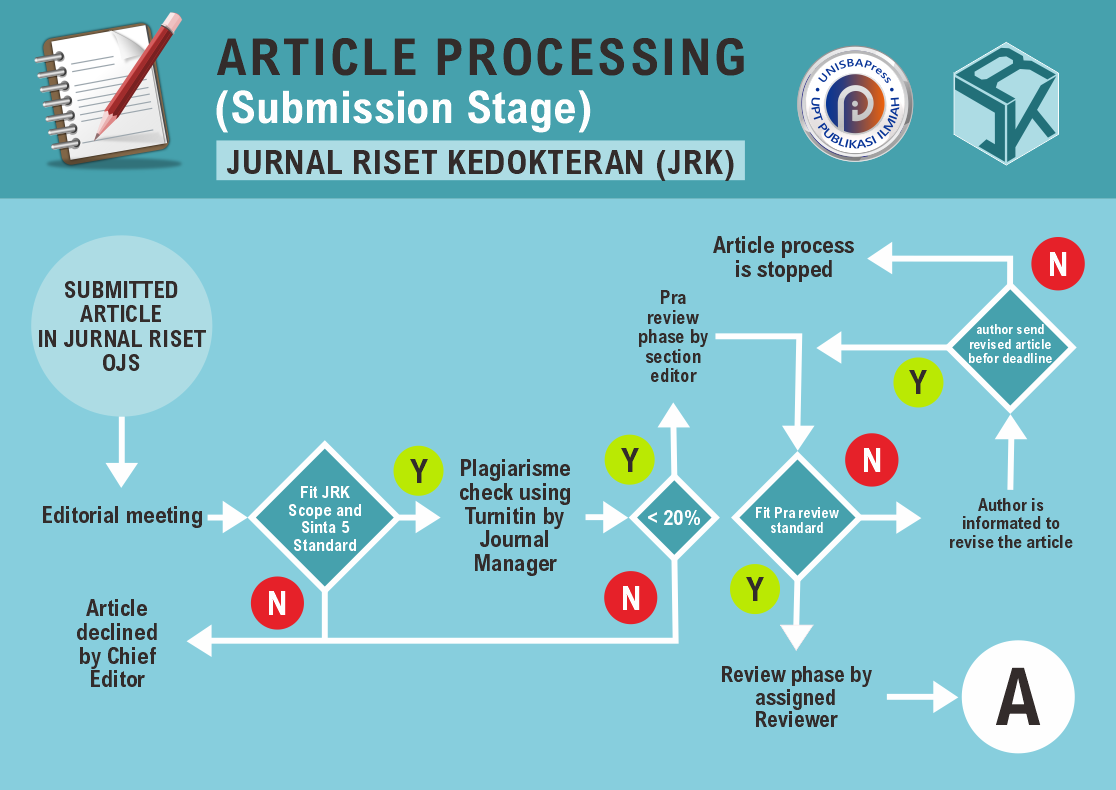Perbedaan Pola Bakteri pada Rongga Mulut Perokok dan Bukan Perokok
DOI:
https://doi.org/10.29313/jrk.v4i2.5009Keywords:
Perokok, Pola bakteri, Rongga mulutAbstract
Abstract. Smoking contributes to higher mortality and morbidity worldwide than any other risk factor. Most side effects occur in the oral cavity, in the form of oral diseases that occur more frequently and treatment is less effective in smoking patients. This study aims to see differences in bacterial patterns in the oral cavity of smokers and non-smokers. This research is a comparative analytical observational study with the chi square test and a cross-sectional approach. The characteristics of the research subjects were that most were aged 21-30 years and most had smoked >10 years. The results of this study showed that more gram-negative and gram-positive bacteria were found in the oral cavities of smokers than in the oral cavities of non-smokers. From this study it can be concluded that there are differences in the pattern of Gram-positive rod bacteria between the two groups (p=0.034). The difference in bacterial patterns in smokers and non-smokers can be caused by the content of cigarettes, namely nicotine, which can weaken the immune system and cause narrowing of blood vessels, including those in the tissue around the teeth. From the results of this research, environmental disturbances caused by smoking can contribute to bacterial patterns in the oral cavity, which ultimately creates a favorable environment for the growth of bacteria that cause periodontal disease.
Abstrak. Merokok berkontribusi terhadap mortalitas dan morbiditas yang lebih tinggi di seluruh dunia dibandingkan dengan faktor risiko lainnya. Efek samping paling banyak terjadi di rongga mulut, berupa penyakit mulut yang lebih sering terjadi dan pengobatan menjadi kurang efektif pada pasien perokok. Penelitian ini bertujuan untuk melihat perbedaan pola bakteri di rongga mulut pada perokok dan bukan perokok. Penelitian ini merupakan studi observasional analitik komparatif dengan uji chi square dan pendekatan potong lintang. Karakteristik subjek penelitian adalah sebagian besar berusia 21-30 tahun dan sebagian besar lama merokok >10 tahun. Hasil dari penelitian ini pada rongga mulut perokok lebih banyak ditemukan bakteri batang gram negatif dan batang gram positif dibandingkan pada rongga mulut bukan perokok. Dari penelitian ini dapat disimpulkan terdapat perbedaan pada pola bakteri batang gram positif antara kedua kelompok (p=0,034). Perbedaan pola bakteri pada perokok dan bukan perokok dapat disebabkan karena kandungan rokok yaitu nikotin yang dapat melemahkan sistem kekebalan tubuh dan menyebabkan penyempitan pembuluh darah, termasuk yang berada di jaringan sekitar gigi. Dari hasil penelitian ini gangguan lingkungan yang disebabkan merokok dapat berkontribusi terhadap pola bakteri pada rongga mulut, yang pada akhirnya menciptakan lingkungan yang menguntungkan bagi pertumbuhan bakteri penyebab penyakit periodontal.
References
A. Hanif Hermawati and · Qurrotu A’yunin Lathifah, ‘Faktor-Faktor yang memengaruhi kandungan nikotin dalam urine pada perokok aktif’, 2023.
E. S. Charlson, J. Chen, R. Custers-Allen, K. Bittinger, and H. Li, ‘Disordered Microbial Communities in the Upper Respiratory Tract of Cigarette Smokers’, PLoS One, vol. 5, no. 12, p. 15216, 2010, doi: 10.1371/journal.pone.0015216.
F. E. Dewhirst et al., ‘The Human Oral Microbiome’, J Bacteriol, vol. 192, no. 19, p. 5002, Oct. 2010, doi: 10.1128/JB.00542-10.
G. Yu et al., ‘The effect of cigarette smoking on the oral and nasal microbiota’, Microbiome, vol. 5, no. 1, 2017, doi: 10.1186/s40168-016-0226-6.
H. Tuominen and J. Rautava, ‘Oral Microbiota and Cancer Development’, Pathobiology, vol. 88, no. 2, pp. 116–126, Mar. 2021, doi: 10.1159/000510979.
J. A. Aas, B. J. Paster, L. N. Stokes, I. Olsen, and F. E. Dewhirst, ‘Defining the normal bacterial flora of the oral cavity’, J Clin Microbiol, vol. 43, no. 11, pp. 5721–5732, Nov. 2005, doi: 10.1128/JCM.43.11.5721-5732.2005.
N. Suzuki, Y. Nakano, M. Yoneda, T. Hirofuji, and T. Hanioka, ‘The effects of cigarette smoking on the salivary and tongue microbiome’, Clin Exp Dent Res, vol. 8, no. 1, pp. 449–456, Feb. 2022, doi: 10.1002/cre2.489.
N. Wahida, H. Kadriyan, and S. R. Aini, “Perbedaan sensitivitas bakteri penyebab otitis media supuratif kronik terhadap antibiotik siprofloksasin dan klindamisin di poli THT RSUD Provinsi NTB,” Jurnal Kedokteran, vol. 5, no. 2, pp. 1–6, 2016.
Nadella R, Syafitri y, Arbaningsih SR, Lubis DM et al., ‘Perbandingan Pertumbuhan Bakteri Rongga Mulut Perokok dan Bukan Perokok di Lingkungan Fakultas Kedokteran Universitas Muhammadiyah Sumatera Utara’, JURNAL IBNU SINA BIOMEDIKA, vol. 2, no. 1, pp. 65–71, May 2018, Accessed: Feb. 06, 2023. [Online]. Available: http://jurnal.umsu.ac.id/index.php/biomedika/article/view/1906
Naura Mufida Marsya, Hendro Sudjono Yuwono, and Oky Haribudiman, “Aktivitas Antibakteri Ekstrak Air Kopi Robusta (Coffea canephora) terhadap Bakteri Pseudomonas Aeruginosa,” Jurnal Riset Kedokteran, vol. 1, no. 1, pp. 55–58, Oct. 2021, doi: 10.29313/jrk.v1i1.317.
P. Oktanauli and N. Q. Heriaw, ‘Distribusi Frekuensi Perubahan Warna Email Gigi Pada Perokok’, Cakradonya Dental Journal, vol. 9, no. 2, pp. 116–120, 2017, Accessed: Jan. 27, 2023. [Online]. Available: https://jurnal.unsyiah.ac.id/CDJ/article/view/9749
S. L. Tomar, S. S. Hecht, I. Jaspers, R. L. Gregory, and I. Stepanov, ‘Oral Health Effects of Combusted and Smokeless Tobacco Products’, Advances in dental research, vol. 30, no. 1. NLM (Medline), pp. 4–10, Oct. 01, 2019. doi: 10.1177/0022034519872480.
T. Lasmini, ‘Identifikasi Bakteri Rongga Mulut Perokok dan Bukan Perokok di Pekanbaru’, 2020. [Online]. Available: http://jurnal.univrab.ac.id/index.php/klinikal
Tania Kusumawardhani and Yuniarti, “Hubungan Tingkat Stres Kerja dengan Keluhan Gigi dan Mulut pada Tendik Laki-laki Universitas X,” Jurnal Riset Kedokteran, pp. 61–66, Jul. 2022, doi: 10.29313/jrk.vi.892.
Tobacco. Accessed: Jan. 12, 2023. [Online]. Available: https://www.who.int/en/news-room/fact-sheets/detail/tobacco













